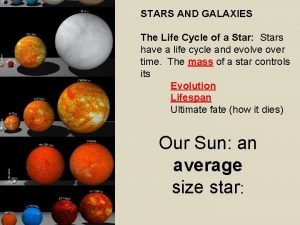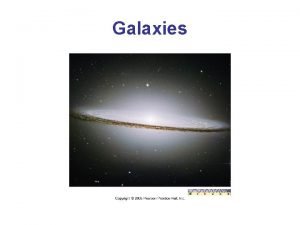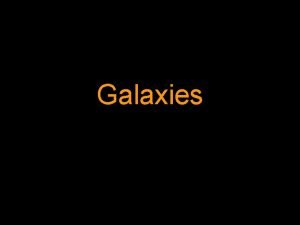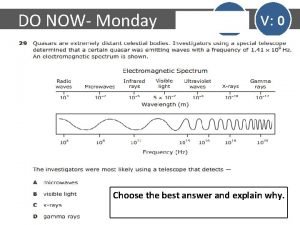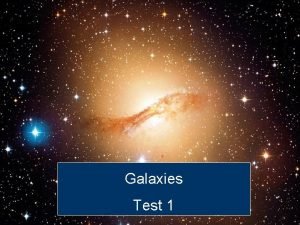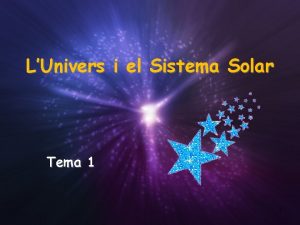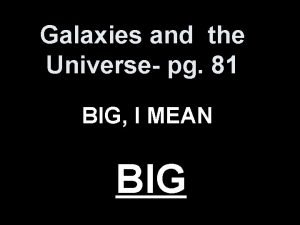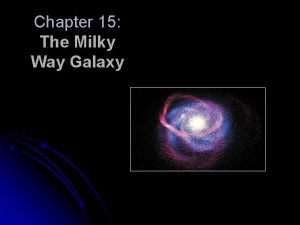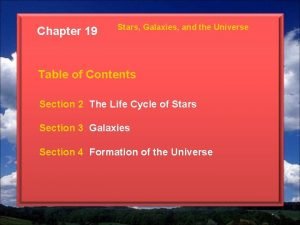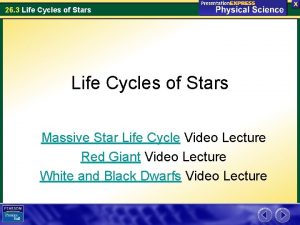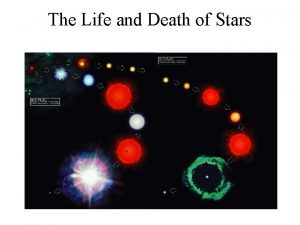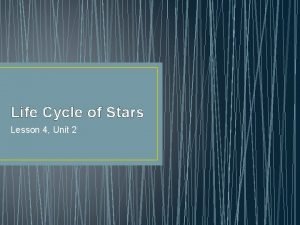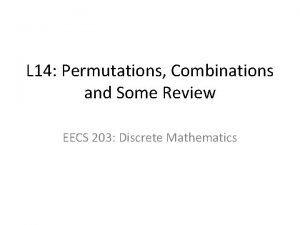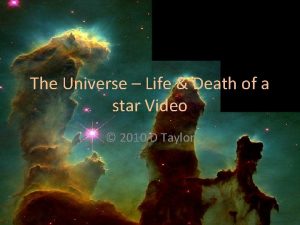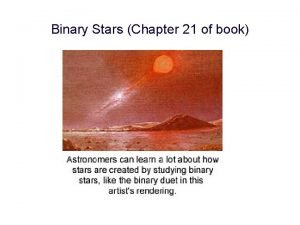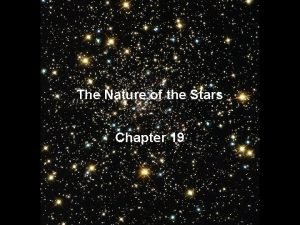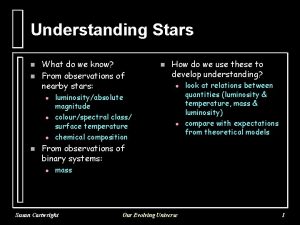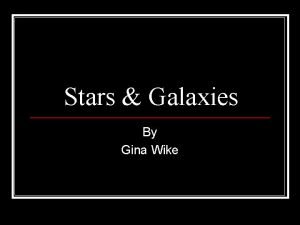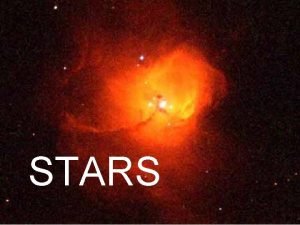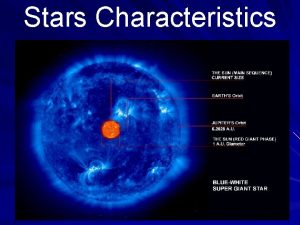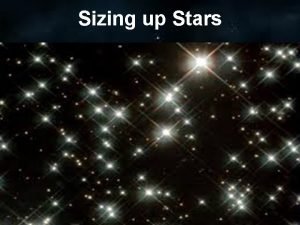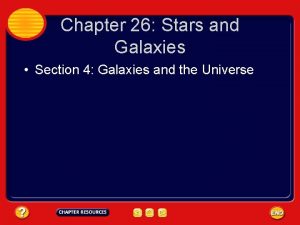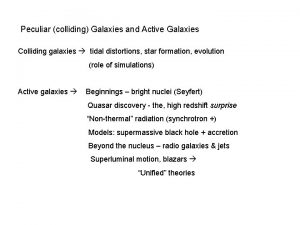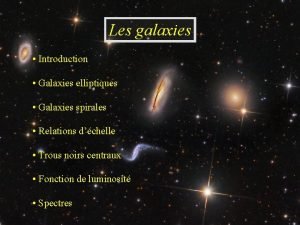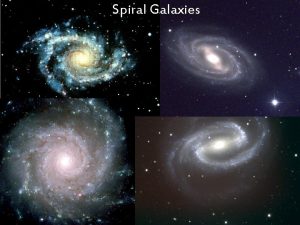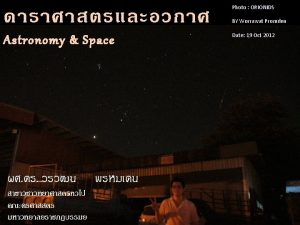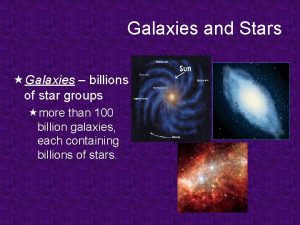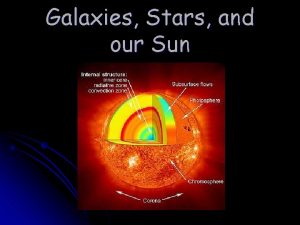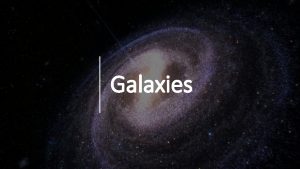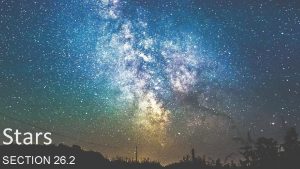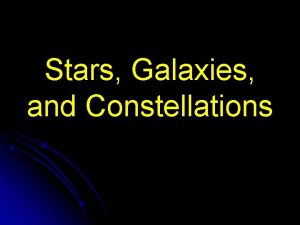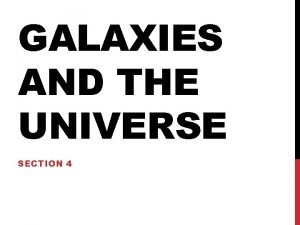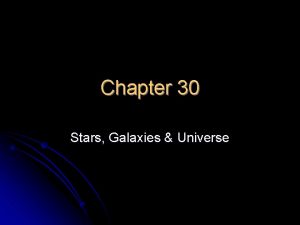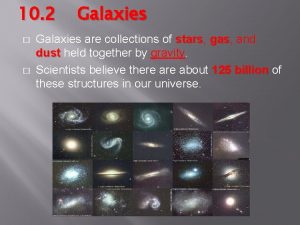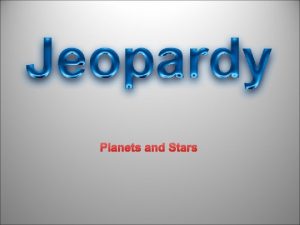C 13 Stars and Galaxies Section 1 Stars





















































- Slides: 53

C 13 : Stars and Galaxies

Section 1 : Stars • • • Demo : expanding universe (p. 369) Q: What is a star ? A: large, massive, hot ball of gas held together by gravity and gives off light. Q: What is a Constellation? A : a number of stars that appear to form a pattern.

Constellations

• Constellations are not real • The purpose is to help to locate stars.


• Stars in a constellation often have no relationship to each other. • Modern astronomy divides the sky into 88 constellations.

Circumpolar Constellations • As Earth rotates, Ursa Major & Ursa Minor and other constellations in the northern sky circle around Polaris. • They appear to move because Earth is rotating. • The stars appear to complete one full circle about 24 hours. • Visible all year long due to their unique position.

• As Earth orbits the Sun, different constellations come into view while others disappear.

Absolute & Apparent Magnitudes • When you refer to the brightness of a star, you can refer to its absolute magnitude or its apparent magnitude. • Absolute magnitude – actual brightness of a star • Apparent magnitude – brightness of a star that we see

Parallax • It can be used to determine the distance of the star from the Earth. • Parallax is the apparent shift in the position of an object when viewed from 2 different positions. • Demo • The nearer an object is to the observer, the greater its parallax.

• Good to cal. distance for near star. • The parallax angle of the closer object is greater than that of the farther object.

Properties of Stars • Color: depends on temperature from coolest to hottest : red, orange, yellow, white, blue • Size : depends on original mass of gas cloud and age/lifestage of star from smallest to biggest : white dwarf, mainsequence, giants, supergiants

• Brightness : depends on surface temp, size, dist from Earth • The light from a star comes from nuclear reactions in center of a star • A star must have a balance between : 1. press due to temp in core 2. Gravity • Study the composition of stars by observing their spectra.

Section 2 : The Sun

• • It is the closest star to Earth. Center of the solar system. It is an enormous ball of gas. It is yellow in color. It is in the main sequence. Brightness : medium The size of the core ~ the size of Jupiter. 92 % hydrogen.

• The Sun has enough hydrogen to last 5 billion years. • It produces energy by nuclear fusion • Energy is transferred by convection and radiation.

The Sun’s Atmosphere • Photosphere – lowest layer of the Sun’s atm. The layer from which light is given off. 6000 K ~ 5700 ºC. • Chromosphere – the layer on top of photosphere. About 2000 km thick.

• Transition Zone – 2000 km to 10 000 km thick. • Corona – largest layer of the Sun’s atm. - extends millions of km into space. - 2 million K - charged ptles escape here as solar wind.

Surface Features • Sunspots – dark color spots on the surface becoz they are cooler than surrounding areas. - they are caused by intense magnetic storms on the Sun. - sunspots move because Sun rotates. Faster at equator (25 days/rotation) and slower at poles (35 days/rotation).

- sunspots are not permanent. - sunspot max : times when many large sunspots occur. Every 10 to 11 years. - sunspot min : occur in between sunspot max.

Prominences and Flares

• Prominence : the intensive magnetic fields associated with sunspots causes prominences. • They are huge, arching columns of gas.

• Solar flares : gases near a sunspot shooting outward at high speed. • CMEs (Coronal mass ejections) - occur when large amts of electricallycharged gas are ejected suddenly from corona. - 2 or 3 times each day during a sunspot max.

• It can damage satellites in orbits. • Interfere radio equipment. • It causes auroras. - high energy ptles contained in CMEs and solar wind are carried past Earth’s magnetic field → generates electric current toward Earth’s poles → ionized gases in atm →ions recombine with electrons →produce ight →aurora.

Aurora

The Sun – An Average Star • • • Middle-aged Brightness is average Yellow light Light reaches Earth ~ 8 mins Not close to any other stars Closest star system to the Sun – The Alpha Centauri System (triple star system)

Section 3 : Evolution of Stars • (I) Classifying Stars • High temps →brighter absolute magnitude • Hertzsprung – Russell (H-R) diag.

• • Most stars (abt 90% of all stars) fit into a diagonal band → main sequence Bigger, hot, blue, bright stars → upper left Smaller, cool, red, dim stars → lower right (most stars found here) Remaining 10% stars not found in main sequence :

1. White dwarfs – hot but not bright - small - lower left of H-F diag 2. Red Giants – large - bright but not hot - upper right - supergiants (largest giants)

Antares • • • Supergiant 400 light years from Earth 3 500 K 16 th brightest star in the sky 300 x diameter of Sun 11 000 times brighter than Sun

How do stars shine/generate energy? • Core of Sun → high temp → H atoms fuse into He → releases huge amt of energy • 4 H nuclei combine to create 1 He nucleus • Mass of 1 He nucleus < 4 H nuclei → mass is lost → energy is produced • E = mc 2 Eg: m=1 kg E = 1 x (3 x 108)2 = 9 x 1016 J → 2. 8 million US hours / year


Demo • P. 382 “make a model”

Evolution of Stars • When hydrogen nuclei (protons) depleted → star loses its main sequence status • Brightest stars → less than 1 million years to deplete • Dimmest stars → many billions of years • Sun – main sequence - life span ~ 10 billion years - 5 billion years left

• What is a Nebula? large and massive cloud of gas and dust particles

How a star is formed? • Due to supernova or collisions of 2 clouds of nebula → ptles of gas and dust exert gravitational force on each other → nebula contracts → instability within nebula → nebula breaks apart into smaller pieces → ptles in smaller pieces of nebula move closer → T increases (ptles collide more as they are closer) → protostar → core reaches 10 million K → fusion begins → star is formed and is stable → stars in main sequence

Star is stable in main sequence becoz heat from fusion causes Press increases → Press balances the gravity → when hydrogen in the core is depleted → gravity > press → core contracts → T inc in core → outer layer expands (more He) → outerlayer temp dec → core temp reaches 100 million K → He nuclei fuse to form Carbon → giant

How a white dwarf is formed? • After the star’s core uses much of its helium (this stage is after giant. The hydrogen fuel has used up → does not produce any new helium nuclei → helium combine to form carbon) → contracts even more (no more fusion → gravity pulls in) → outer layers escape into space → leaves behind the hot, dense core.

• Size of Earth • Eventually the white dwarf will cool and stop giving light

Supergiants and Supernovas • Stars more than 8 x massive than Sun → evolution occurs more quickly and more violently • Massive stars → core heats up to higher temps → heavier elements form by fusion (becoz higher temp is needed to fuse bigger elements. Eg : He → C needs higher temp) → star expands into supergiant → iron forms in the core → iron atomic structure does not release energy through fusion → core collapses (exploded) → shock wave

Neutron Stars • If the collapsed core of a supernova (after the explosion) is ~ 1. 4 → 3 times the mass of Sun → shrink to ~ 20 km in diameter → only neutrons can exist in the dense core → neutron star

Black Holes • If the collapsed core of a supernova is > 3 times the mass of Sun → continue to collapse → until it becomes a point → gravity near this mass is so strong that nothing can escape from it, not even light → black hole • Black hole is not like a giant vacuum cleaner sucking in distance objects • Only if the object crosses it → pulled into the hole • Stars and planets can orbit around a black hole

Section 4 : Galaxies and the Universe • Galaxy : a large group of stars, gas, and dust held together by gravity. (also includes planets) • Milky Way Galaxy : our galaxy • Galaxies are separated by huge distances – millions of light years apart. • Galaxies are grouped together into clusters • Stars (gp) → galaxies(gp) → clusters • Milky Way belongs to Local Group Cluster (~45 galaxies)

3 Major types of Galaxies 1. Spiral Galaxies • Whirlpool – like • Lots of dust in spirals • Closer to center →faster it orbits • Milky Way

2. Elliptical Galaxies • 3 -D ellipses : football • Round : soccer ball • No spirals • Very little dust

3. Irregular Galaxies • No recognizable shape • Smallest type of galaxy • 2 irregular galaxies orbit the Milky Way → Clouds of Magellan

The Milky Way Galaxy • ~ 1 trillion stars • Stars (including Sun) orbit around the core. It takes 225 million years for the Sun to make 1 round around the core. • Has a supermassive black hole at its center. It is about 2. 5 million times as massive as the Sun.

Origin of the Universe 1. Steady State Theory – the universe always has been the same as it is now. The universe always existed and always will. • Evidence indicates that the universe was different in the past.

2. Oscillating Model – universe began with expansion → expansion slowed → universe contracted →process began →oscillating back and forth. 3. Big Band Theory – started with a big band →expanding ever since.

Doppler Shift • If a star is moving toward Earth, its wavelength of light are compressed →light from the star is shifted to the blue end of the spectrum. • If a star is moving away from Earth, its wavelength stretched →light from the star is shifted to the red end of the spectrum.



• Red Shift → Universe is expanding • Quick Demo (p. 389)
 What waves are produced by stars and galaxies
What waves are produced by stars and galaxies Chapter 30 galaxies and the universe
Chapter 30 galaxies and the universe Galaxie s
Galaxie s The stars there are millions of stars in the sky
The stars there are millions of stars in the sky Life cycle of a galaxy
Life cycle of a galaxy Facts about elliptical galaxies
Facts about elliptical galaxies E irregulars
E irregulars Era of galaxies
Era of galaxies Milky way galaxy shape
Milky way galaxy shape Types of galaxies
Types of galaxies Brainpop galaxies quiz answers
Brainpop galaxies quiz answers 4 types of galaxies
4 types of galaxies How are active galaxies classified?
How are active galaxies classified? Tipus de galaxies
Tipus de galaxies Type of galaxy
Type of galaxy Evolution of galaxies
Evolution of galaxies Universepg
Universepg Galaxies lesson plan
Galaxies lesson plan Chapter 19 section 2 the life cycle of stars answer key
Chapter 19 section 2 the life cycle of stars answer key Section 26.3 life cycles of stars
Section 26.3 life cycles of stars Partial section view
Partial section view Section 2 describing energy
Section 2 describing energy Revolved view
Revolved view Sectional view drawing
Sectional view drawing Concept mapping chapter 10 meiosis 1 and meiosis 2
Concept mapping chapter 10 meiosis 1 and meiosis 2 Two stars and a wish template
Two stars and a wish template What is the life cycle of a medium mass star
What is the life cycle of a medium mass star The life and death of stars
The life and death of stars Number the stars chapter 10
Number the stars chapter 10 Star with small and medium mass
Star with small and medium mass Coefficient of x
Coefficient of x Hertzsprung russell worksheet
Hertzsprung russell worksheet Two stars and a wish template
Two stars and a wish template Life and death of stars
Life and death of stars The plough and the stars characters
The plough and the stars characters Watching and seeing shooting stars on a dark night
Watching and seeing shooting stars on a dark night Why do disk stars bob up and down as they orbit the galaxy?
Why do disk stars bob up and down as they orbit the galaxy? The plough and the stars characters
The plough and the stars characters Stars dogs plowhorses and puzzles
Stars dogs plowhorses and puzzles Binary star book
Binary star book Why isn't kirsti afraid of the soldiers
Why isn't kirsti afraid of the soldiers Favourite tv channel
Favourite tv channel The stars and i chapter 19
The stars and i chapter 19 Nanastars
Nanastars When the stars threw down their spears explain
When the stars threw down their spears explain Life cycle of a star notes
Life cycle of a star notes Symbolism
Symbolism Sun and rigel
Sun and rigel Big and little dipper
Big and little dipper How do scientists classify stars?
How do scientists classify stars? Characteristics of a star
Characteristics of a star Where do stars come from
Where do stars come from Color of the stars from coolest to hottest
Color of the stars from coolest to hottest Shooting stars analysis
Shooting stars analysis




